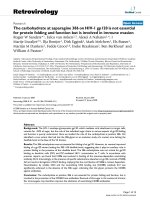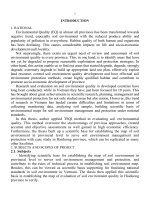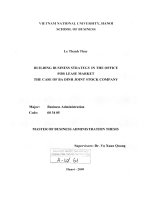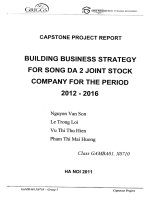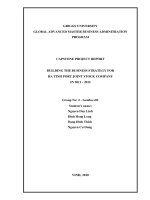RECOMMENDATIONS FOR BUILDING, MANAGING AND PROTECTING THE BRAND EQUITY IN VIASIA JOINT STOCK COMPANY
Bạn đang xem bản rút gọn của tài liệu. Xem và tải ngay bản đầy đủ của tài liệu tại đây (572.74 KB, 46 trang )
NATIONAL ECONOMICS UNIVERSITY
FACULTY OF FOREIGN LANGAUGES
ENGLISH FOR BUSINESS DEPARTMENT
~~~~~~*~~~~~~
TRUONG THUY CHI
RECOMMENDATIONS FOR BUILDING, MANAGING
AND PROTECTING THE BRAND EQUITY IN VIASIA
JOINT STOCK COMPANY
Hanoi, May, 2012
NATIONAL ECONOMICS UNIVERSITY
FACULTY OF FOREIGN LANGAUGES
ENGLISH FOR BUSINESS DEPARTMENT
~~~~~~*~~~~~~
TRUONG THUY CHI
RECOMMENDATIONS FOR BUILDING, MANAGING
AND PROTECTING THE BRAND EQUITY IN VIASIA
JOINT STOCK COMPANY
Supervisor:
Tran Thi Thu Giang, M.A
Hanoi, May, 2012
Trương Thuỳ Chi- CQ503891- Business English 50A
ACKNOWLEDGEMENT
I would like to express my gratitude to all those who gave me the possibility to
complete this research. I want to thank the Viet A Plastic Joint Stock Company for
giving me an opportunity to practice and learn at there, and also give me permission to
commence this study in the first instance, to do the necessary research work and to use
department data. I have furthermore to thank the bosses, Mrs. Tran Bich Thuy, the
Financial Director and Mr. Tran Trung Duong, the General Director who gave and
confirmed this permission and encouraged me to go ahead with my research.
I am deeply indebted to my supervisor M.A. Tran Thi Thu Giang from the Faculty of
Foreign Languages, English for Business Department whose help, stimulating
suggestions and encouragement helped me in all the time of research for and writing of
this report.
My colleagues from Viet A Joint Stock Company supported me in my research work. I
want to thank them for all their help, support, interest and valuable hints. I also want to
thank many students from Nguyen Phong Sac Secondary School, National Economics
University, and employees from Hung Thuan Plastic Company, Huu Nghi Plastic
Company and Lac Viet Media Company who support me to answer my questions and
many Viet A Company’s consumers who help me to complete my survey.
Especially, I would like to give my special thanks to my family and my friends who
give me many conditions to complete this study.
i
Trương Thuỳ Chi- CQ503891- Business English 50A
TABLE OF CONTENTS
ACKNOWLEDGEMENT............................................................................................... i
EXECUTIVE SUMMARY...........................................................................................iv
INTRODUCTION.......................................................................................................... 1
1. Research topic.........................................................................................................1
2. Rational................................................................................................................... 2
3. Research question...................................................................................................2
4. Scope of the research..............................................................................................2
5. Methodology...........................................................................................................2
CHAPTER I: INTRODUCTION OF THE VIET A PLASTIC JOINT STOCK
COMPANY AND THEIR PROBLEMS ABOUT BRAND EQUITY...........................4
1. Viet A Plastic Joint Stock Company.......................................................................4
2. Problems about brand equity in Viet A Plastic Joint Stock Company.....................5
CHAPTER II: OVERVIEW OF BUILDING AND MANAGING BRAND EQUITY
FOR A BUSINESS........................................................................................................6
1. Brand equity............................................................................................................6
1.1. Definition..........................................................................................................6
1.2. Elements of brand equity..................................................................................7
1.3. Brand Awareness..............................................................................................7
1.4. Perceived quality..............................................................................................8
1.5. Sources of brand equity....................................................................................9
2. The concept of Customer- Based Brand Equity......................................................9
2.1. Definition..........................................................................................................9
2.2. How to create strong brand based on Customer- based brand equity..............10
3. The Benefits of Brand Equity................................................................................10
4. Protecting and Managing Brand Equity................................................................12
4.1. Managing Brand Equity..................................................................................12
ii
Trương Thuỳ Chi- CQ503891- Business English 50A
4.2. Protecting Brand Equity..................................................................................13
CHAPTER III: ANALYSIS AND FINDINGS............................................................14
1. Viet A Brand Equity..............................................................................................14
1.1. Customer’s awareness of plastic doors...........................................................14
1.2. Brand recognition...........................................................................................16
1.3. Viet A brand awareness..................................................................................17
2. The ways that Viet A build the brand equity and its results..................................18
2.1. Customer’s reaction to promotion...................................................................18
2.2. Customer’s satisfaction...................................................................................18
3. Problems in brand equity of Viet A Plastic Joint Stock Company........................21
3.1. Problems in product’s criteria.........................................................................21
3.2. Problems in Viet A slogan..............................................................................22
4. Common evaluation..............................................................................................22
4.1. Advantages of Viet A Plastic Joint Stock Company.......................................22
4.2. Difficulties of Viet A Plastic Joint Stock Company........................................23
CHAPTER IV: RECOMMENDATIONS....................................................................24
1. Building and Managing Brand Equity...................................................................24
1.1. Building Customer- Based Brand Equity........................................................24
1.2. Building Brand Awareness.............................................................................25
1.3. Building Perceived Quality.............................................................................27
2. Managing Brand Equity........................................................................................27
3. Protecting brand equity.........................................................................................28
CONCLUSION............................................................................................................ 31
APPENDIX.................................................................................................................. 32
REFERENCES............................................................................................................. 39
iii
Trương Thuỳ Chi- CQ503891- Business English 50A
TABLE OF FIGURES
Figure 1: Customer's knowledge of plastic doors......................................................14
Figure 2: Customer's usage of plastic doors..........................................................15
Figure 3: Percentage of brand recognition.................................................................16
Figure 4: Viet A Brand Awareness............................................................................17
Figure 5: Customer's reaction to promotion.........................................................18
Figure 6: Customer's satisfaction of Viet A product quality and service...................19
Figure 7: Customer' satisfaction of Viet A product price...........................................19
Figure 8: Customer's evaluation criteria about Viet A plastic door products....21
Figure 9: Customer's evaluation about Viet A slogan................................................22
iv
Trương Thuỳ Chi- CQ503891- Business English 50A
EXECUTIVE SUMMARY
The study was researched at the Viet A Plastic Joint Stock Company about the
problems of building, managing and protecting brand equity. The research was carried
on from March 5th to March 30th with multiple objects of different ages (from 15 to 50
years old) and different careers. After the researching process, the researcher can point
out several problems about brand equity in Viet A Company and also suggest some
solutions to deal with these problems.
Findings:
The brand awareness of Viet A Company is low. Although the price is lower
than other competitors, the company cannot attract a lot of customers
The slogan is not impressed with customers and they cannot remember it
The company does not have financial support for the advertising
Recommendations:
Building customer- based brand equity to gain the customer’s confidence
Building brand awareness: through improve customer service and advertising
activities
Building perceived quality: depends on the customer’s evaluation criteria
Protecting brand equity: through the marketing mix elements
v
Trương Thuỳ Chi- CQ503891- Business English 50A
INTRODUCTION
1. Research topic
Building brand equity is a long process and requires a huge expenditure. According to
researchers, the strong corporations and companies in the world spend about 10% of its
revenue on advertising to building brands. However, the number of studies to enhance
brand equity is not much in Vietnam. The ignorance about building and managing
brand equity in some small and medium enterprises in Vietnam put them to a difficult
situation to compete to larger companies, specially, from abroad.
At the international trade fair about brands which was held in 2004 in Vietnam, the
Deputy Minister of Science and Technology, Mr. Le Dinh Tien said that: “Brand
equity of a business is the reputation. Building brand equity is one of the ways to
compete in the market” (2009). Mr. Thomas B. Shepard- the Executive Vice President
of Marketing and International funding in Visa International also completely agree that
the brand equity will survive as a part of the most important assets of the company
(2009). Therefore, a business which wants to operate in a long – term and sustainable
development, needs to pay more attention to building and managing its brand equity,
because that is the key measurement to evaluate business’ development. Brand equity
is not only a symbol, but also an effective tool to maintain and develop in the domestic
and aboard market in the future. That is the reason why some people said that brand
equity is the money, the profit of enterprises.
According to the report about “The situation of building brand equity in Vietnam”
(MA. Dang Ngoc Su, 2012), the result of a consumer surveys which was launched in
Ho Chi Minh City pointed out that 89% of consumers used brand as a main factor to
selecting products. That means consumers will be loyal to the brand if they trust the
brand-name products. To create the customer’s confidence, one of the main factors is
to create the long- term relationship. The business needs to reflect and express
simultaneously in all three aspects: reliability, honesty and sustainability.
Therefore, understanding about the brand equity, the business would provide the
explanation of problems which occur in the market and bring out the suitable solution
at right time and right place to strengthen its brand equity.
1
Trương Thuỳ Chi- CQ503891- Business English 50A
2. Rational
Recently, the rapid growth in manufacturing and trading plastic door leads to many
problems in competition between enterprises. One of them is the brand equity, which
plays an important role in increasing awareness and improving engagement of
customers in the Vietnamese market. The Viet A Plastic Joint Stock Company was also
faced with that problem. Without the difference in products’ quality and customers’
service, it is very difficult to gain the customer’s confidence for Viet A Company than
other big enterprises (such as Euro window). Therefore, the purpose of this study is to
determine the Viet A Plastic Joint Stock Company’s brand equity in Vietnamese plastic
door like name awareness, perceived quality and so on. Moreover, this research also
applies these lessons to offer suggestions and solutions in improving and strengthening
the brand equity for Viet A Plastic Joint Stock Company.
3. Research question
This study was designed to analyze the customers’ views about Viet A Plastic Joint
Stock Company’s products and services to get the conclusion about its brand equity.
Specifically, the study seeks the answers to three questions:
1. What is Viet A brand equity?
2. What are the ways that Viet A build their brand equity?
3. What are the problems in brand equity of Viet A Plastic Joint Stock Company?
4. Scope of the research
The research is carried out from March 5th to April 10th, through the data launched by
Viet A Plastic Joint Stock Company, the reports and information from the internet. At
the same time, the survey and interviews also will be conducted through the Internet
and social network.
5. Methodology
The research will follow this methodology:
Survey: from March 5th to March 25th, there are 200 surveys were sent and 188
surveys were received. The age of people surveyed from 14 to 50 years old.
Most of them are the officers, who pay much attention to the products. There is
2
Trương Thuỳ Chi- CQ503891- Business English 50A
a survey for the Viet A Company’s customers and a survey for the Vietnamese
customers.
Interview: from March 20th to March 30th, there are 30 people were interviewed.
They are pupils at Nguyen Phong Sac High School, students at National
Economics University, employees at Hung Thuan Plastic Company, Huu Nghi
Plastic Company and Lac Viet Media Company. The researcher also interview
…
3
Trương Thuỳ Chi- CQ503891- Business English 50A
CHAPTER I: INTRODUCTION OF THE VIET A PLASTIC JOINT STOCK
COMPANY AND THEIR PROBLEMS ABOUT BRAND EQUITY
1. Viet A Plastic Joint Stock Company
Viet A Company was established in September, 2007 with the full name is Viet A
Plastic Joint Stock Company. In the first years, Viet A Company has faced many
difficulties in both financial and human resources. At that time, the Vietnamese plastic
door market has been manipulated by the pioneers Eurowindow. Moreover, by this
time, using plastic doors has not become popular in Vietnam. The Vietnamese
consumers tended to spend wood doors than plastic door which requires a lot of
money. In December, 2009, the company operated a brand in Ho Chi Minh City with
the purpose is to explore the southern market. This is a remarkable step of Viet A
Plastic Joint Stock Company in expanding the Vietnamese market, gaining the
customer’s confidence and building the brand equity.
However, overcoming many difficulties, after nearly 5 years, Viet A Plastic Joint Stock
Company has achieved many certain successes in the Vietnamese plastic doors market.
The company has recently cooperated with many large construction companies such as
Van Phu- Invest Investment Joint Stock Company, Hanoi Housing Development and
Investment Corporation and so on. It was received certification from the International
Organization for Standardization- ISO 9001:2008, Gold medal from Viet Build
Exhibition in Hanoi in 2011.
Background information about Viet A Company
Name of transaction: Viet A Plastic Joint Stock Company
Name abbreviations: VIASIA, Inc
Head office: 23 Dong Cac Street, Dong Da District, Hanoi
Tel: 042.221.2628 Fax: 043.511.3561
Southern brand: 242/16 Tay Thanh Street, Tan Phu District, Ho Chi Minh City
Tel: 086.267.6090
Email:
Website: www.cuanhuavieta.com.vn
4
Trương Thuỳ Chi- CQ503891- Business English 50A
2. Problems about brand equity in Viet A Plastic Joint Stock Company
Despite achieving many successes in the Vietnamese plastic doors market, the
company still faces many challenges. One of main difficulties is how to build and
manage the brand equity. Brands have higher brand equity to the extent that they have
higher brand loyalty, name awareness, perceived quality, strong brand associations and
so on. After an internship period in Viet A Company, the researcher found that this
company has cooperated with Eurowindow in producing many details and products
which play an important role in assemble the Eurowindow’s products in the
Vietnamese market. Therefore, the researcher can assume that the Viet A Company’s
product quality and Eurowindow’s product quality are equal. Besides, because
Eurowindow is a large company from Europe and also have strong brand, the cost
which customers have to pay for Eurowindow’s products is always higher than those of
other plastic door manufacturers from one to three million for a product. However, this
company still attracts a large number of customers in the Vietnamese market.
According to the data launched in 2012 by Viet A Company, the brand awareness of
Euro window in Vietnamese plastic doors market account for 57.6%, while Viet A
Plastic Joint Stock Company just made up 1,28%. To explain this situation, this study
will focus on the Viet A Company’s brand equity. Because of limited time and
conditions, the study will do research and give commendations in two main factors of
brand equity: brand awareness and perceived quality.
5
Trương Thuỳ Chi- CQ503891- Business English 50A
CHAPTER II: OVERVIEW OF BUILDING, MANAGING AND
PROTECTING BRAND EQUITY FOR A BUSINESS
1. Brand equity
1.1. Definition
Brands vary in the amount of power and value they have in the marketplace. Some
brands are largely unknown to most buyers. Other brands have a high degree of
consumer brand awareness. Still others enjoy brand preference- buyers select them
over the others. Finally, some brands command a high degree of brand loyalty.
A powerful brand has high brand equity. Brands have higher brand equity to the
extent that they have higher brand loyalty, name awareness, perceived quality,
strong brand associations, and other assets such as patents, trademarks, and channel
relationships. A brand with strong brand equity is a valuable asset. In fact, it can
even be bought or sold for a price (Gary Armstrong, Philip Kotler, Principle of
Marketing, 7th Ed).
According to Wikipedia.com, brand equity is a phrase used in the marketing
industry to try to describe the value of having a well- known brand name, based on
the idea that the owner of a well- known brand name can generate more money
from products with that brand name than from products with a less well known
name, as consumers believe that a product with well- known name is better than
products with less well- known names. Another word for “brand equity” is “brand
value”.
Brand equity represents a relevant research line in marketing. This concept has
undergone an important evolution in its understanding and in the variable that
comprise it. Brand equity was born a simple construct in the late 1980’s, with a
single variable meaning changed according to each author: the additional price a
consumer is willing to pay for a brand; the extension capacity of a brand; the
financial value of a brand as an intangible asset; or its capacity for generating
loyalty among customers. Nowadays, brand equity has to be understood as “brand
equity based on customer” or customer- based brand equity (“Study of the Brand
Equity Based on Customer Loyalty”, Ph. D. Andy, 2012).
6
Trương Thuỳ Chi- CQ503891- Business English 50A
1.2. Elements of brand equity
According to “Managing Brand Equity” by David Aaker (1991), there are four
elements of brand equity:
Brand Loyalty: Brand loyalty is a measure of the attachment that a customer has
to a brand. It reflects to how likely a customer will be to switch to another
brand, especially when that brand makes a change, either in price or in product
features.
Brand Awareness: Brand Awareness is the ability of a potential buyer to
recognize or recall that a brand is a member of a certain product category.
Perceived Quality: The customer’s perception of the overall quality or
superiority of a product or service with respect to its intend purpose, relative to
alternatives. Perceived quality is a perception by customers.
Brand Association: A brand association is anything “linked” in memory to a
brand.
1.3. Brand Awareness
In “Managing Brand Equity” (1991), David Aaker pointed out three elements
which related to brand awareness.
1.3.1. Brand Awareness Hierarchy
Top of Mind
Brand Recall
Brand Recognition
Unaware of Brand
1.3.2. Value of Brand Awareness
Anchor to which other associations can be attached
Familiarity and liking
Signal of substance/ commitment
Brand to be considered
1.3.3. How to achieve Brand Awareness
Be different, memorable
7
Trương Thuỳ Chi- CQ503891- Business English 50A
Involve a slogan or jingle
Symbol exposure
Publicity
Event sponsorship
1.4. Perceived quality
David Aaker (1991) listed the influences perceived quality of products and services
and the value of perceived quality ( Managing Brand Equity)
1.4.1. Influences Perceived Quality of Products
Performance
Features
Conformance with specifications
Reliability
Durability
Serviceability
1.4.2. Influences Perceived Quality of Services
Appearance
Reliability
Competence
Responsiveness
Empathy
1.4.3. Value of Perceived Quality
Reason- to- buy
Position
A price premium
Channel member interest
Brand extensions
1.5. Sources of brand equity
Marketing Research: Introducing brand in the market needs quantities or
qualitative research to get familiar with the trends and different attributes.
8
Trương Thuỳ Chi- CQ503891- Business English 50A
Proper market research allows the company to launch a right brand for the right
segment.
Quality: New product must incorporate quality ingredient because first
impression is the last impression. If customers are satisfied with the quality of
your products then customers will suggest other people to go for this product by
sharing good thoughts.
Brand Name: Brand name should be related to the product and easy to
remember.
Brand Positioning: Position brand is such a way that customers can remember it
for a long time and position in his mind.
Marketing Mix: The proper use of marketing mix adds value in the brand
marketing. Promotion and personal relation increase brand equity.
Brand Extension: To polish your brand, bring some new products and services
under of umbrella of same brand name.
Customer opinion: Always look for customers’ opinion because they know the
best and the worst about the products.
2. The concept of Customer- Based Brand Equity
2.1. Definition
We have known about what is brand equity. From customers’ point of view,
association created which results in favorable and positive action towards a brand,
in context with other product can be referred as brand equity. If that action is in
favor of any brand than is positive brand equity and that action is not favorable than
its negative brand equity. And since this brand equity is from customers’
perspective, Customer- Based Brand Equity.
To further stress point of brand knowledge, an experiment was conducted by Larry
Percy with respect to brand equity. Result lead to conclusion that brand knowledge
contributes a lot in understanding customer- based brand equity.
Brand knowledge which is crucial in evolution of brand equity consists of brand
awareness and brand image. As the author said above, brand awareness means the
ability created by brand with which consumer can recall and recognize in any give
9
Trương Thuỳ Chi- CQ503891- Business English 50A
environment. On the other hand, brand image are visuals, logo, style and so on with
which brand is associated. Customer- based brand equity results in creation of
strong brand and this is achieved when brand awareness and image are at high
level.
2.2. How to create strong brand based on Customer- based brand equity
Brand equity resides in the mind of the customer, so conviction has to be brought in
strategy as to permanently occupy consumer mind space. First step is to establish a
relation between customer need and product offering, meaning for given product
the brand is the best customer can get. This is done by appropriate brand awareness
and image. Second step is connection, by churning out predictable, reliable and
quality performance during each purchase. This establishes imprint in customers’
mind which further can be cemented by visual, logos, packaging, quality, customer
service, warranty and so on. Next, create emotional level response in form of
positive reaction or opinion brand creates long term, sustainable and healthy
relationship.
3. The Benefits of Brand Equity
Consumers have different reactions before the commercial activities, in the
presence of known brands and before unknown ones. A real brand equity for a
consumer is brought forward from the relevant knowledge of the brand with a set of
favorable associations in a given purchase decision context. The brand generates
real value for the consumer when the brand is perceived in a differentiable, special
and attractive manner from other rival brands. When brand value is generated for
the consumer, benefits can be expected for the company that owns the brand.
Briefly, this creation of value has benefits: Allows generating greater loyalty from
the consumers by increasing the value offered to them; Allows for a reduced
vulnerability to strategic marketing moves by competitors and market crises;
Reduces the elasticity of demand facing a greater value; Helps generate trust and
support from the distribution channels already stimulated to work with higher value
brands.
10
Trương Thuỳ Chi- CQ503891- Business English 50A
Sponsoring products with higher value brands allows for increased effectiveness of
the communication efforts directed towards the consumer, because a recognizable
and valuable element is attached to them.
Higher value brands usually possess broader umbrella effects that allow for more
successful brand extensions by transferring the perceived brand value towards the
new business entities. With the brand overpricing, companies can manage ampler
profit margins than other competitors with lesser value brands. This last argument
concentrates all the relevance related to the strategic management of brands and
justifies the marketing management based on “brand equity”. This relevance stems
from the increased margins of profit that companies with greater relative market
share tend to generate, and at the same time it is these market leaders who generally
own the greater value brands in their industrial sectors. David Arnold demonstrates
this argument when he talks about three principles of brand performance:
First, there is evidence to assert that the market leaders tend to receive such
advantage as a result of generating brands with grater “perceived quality”, and
not solely due to the inherent quality of their products, thus making this
“perceived quality” one of the key aspects to maintain market leadership.
Having achieved this leadership, additional benefits can be attained, such as
greater negotiation power with customers and clients.
Second, although leading companies in the market tend to be businesses with
greater efficiency production systems based in economies of scale, when
approached on a case to case basic, it seems that it was the greater perceived
quality brands which allowed their companies to overtake their competitors and
then be at ease to implement these more efficient cost structure and from a
greater competitive power that allows them to implement superior pricing. This
advantage of being able to handle higher process derives directly from the
superior value of their brand.
Last, greater perceived quality brands provide a long term competitive
advantage for the companies, because, if maintained adequately, they are not
subject to a product life cycle. Brands can outlast their products if renewed and
11
Trương Thuỳ Chi- CQ503891- Business English 50A
modified in their associated perceptions to maintain their validity in loyal
consumer groups
Well managed brands must be understood as tools to establish long term
relationships with clients. The composition of brand equity is complex. It is
known that a buyer is willing to pay an over price for a product bearing high
perceived value brand, although the value of this same brand is influenced to a
great degree by the quality of the product it sponsors.
4. Protecting and Managing Brand Equity
4.1. Managing Brand Equity
In his 1989 paper, “Managing Brand Equity”, Peter H. Faquhar outlined the
following three stages that are required in order to build a strong brand:
Introduction: introduce a quality product with the strategies of using the brand
as a platform from which to launch the future products. A positive evaluation by
the consumer is very important.
Elaboration: make the brand easy to remember and develop repeat usage. There
should be accessible brand attitude, that is, the consumer should easily
remember his or her positive evaluation of brand.
Fortification: the brand should carry a consistent image over time to reinforce its
place in the customer’s mind and develop a special relationship with the
customer. Brand extensions can further fortify the brand, but only with related
products having a perceived fit in the mind of the customer.
4.1.1. Licensing
Most manufactures have to take many years and spend millions to create their
own brand names.
Some criteria for brand name selection such as: be easy to learn and remember,
suggest the product class, support a symbol or slogan, be distinctive and so on.
4.1.2. Brand Repositioning
However well a brand is initially positioned in a market, the company may have
to reposition it later. A competitor may launch a brand positioned next to the
12
Trương Thuỳ Chi- CQ503891- Business English 50A
company’s brand and cut into its market share. Or customer wants may shift,
leaving the company’s brand with less demand. Marketers should consider
repositioning existing brands before introducing new ones. In this way, they can
build on existing brand recognition and consumer loyalty.
4.2. Protecting Brand Equity
The marketing mix should focus in building and protecting brand equity. For
example, if the brand is positioned as a premium product, the product quality
should be consistent with what consumers expect of the brand, low sale prices
should not be used compete, the distribution channels should be consistent with
what is expected of a premium brand, and the promotional campaign should
build consistent associations
Finally, potentially dilutive extensions that are inconsistent with the consumer’s
perception of the brand should be avoided. Extensions also should be avoided if
the core brand is not yet sufficiently strong.
CHAPTER III: ANALYSIS AND FINDINGS
13




